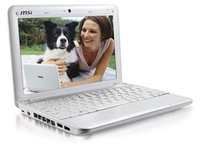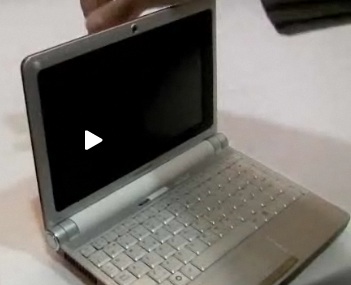Reader Cody Blotske picked up an MSI Wind a few days ago and he promised he'd share his first-hand impressions of using the mini-notebook. Cody is a real user doing real things on a real Wind and we thought his views would have more meaning than all the reviews in the world so here is Cody's take on using the MSI Wind (big thanks for sharing this with everybody!):
MSI Wind by Cody Blotske
I was going to touch base with you on how I felt about the Wind sooner, but you both seemed to be a little busy the last few days. Congratulations again on the GigaOM deal. I just listened to MOTR 140 and thought I would give you my 'one week' impression. I paid $500 for the Black Wind with XP and 3 cell battery by the way, not $600.
I paid for over night and received the Wind at 1:30 at work (my boss is a mobile tech fan so it was ok). I had a plane to catch that took off at 6:00 so I had little time to play with it before I had to put it in my gadget bag and fly off into the sunset. I have to say, its amazing to walk through the airport with a 3 lbs gadget bag. All I packed in it was the Wind, ac adapter, 4 inch USB cable, Sony inner ear headphones, and Logitech VX Nano mouse. With the gadget bag and my Dash I never thought, "I wish I had ...."
The Wind is a great laptop. I mean laptop too. Even with the laptop running in eco mode it runs everything great. For example: While I was listening to MOTR 140 I was listening to it using my Jabra BT620 stereo Bluetooth headphones while Opera (6 tabs open), Rhapsody installing, Live messenger (3 conversations), and Live Mail (typing this e-mail) were running. The audio never paused and whatever I was doing never slowed down. I will admit, I didn’t expect it to handle it that well. I had most of that running just to watch it start to choke, but it didn’t (I will try harder later today). I have only used it heavily for about 4 days, but so far it's amazing how well the atom performs.
The only problems I have had with it was the WIFI drivers it comes with. They are terrible and I wouldn’t wish them upon anyone. It would drop a connection and be unable to find any WIFI networks when my Dash could see 4. It then out of nowhere would start to work. A quick driver install and a reboot took care of it. I haven't had any issues after the update.
The only slow app is the MSI 'system control manager.' It does its job very well, but the graphic that it uses are kind of janky. Brightness and volume graphics, I'm looking at you. There is a lag between where the setting is and what the graphics show. I will admit the graphics look great and polished when they aren't fluid at all.
Another thing that is annoying is they decided to put the Function button where the CTRL button should be. They made the period key half the size it should be. I got used to the period issue after typing a '/' instead of a period about 5 - 10 times. I'm still typing X or C when I'm trying to cut or copy all the time. It might take some time to get over that one. Since I'm talking about the keyboard let me say it right now, this is one of the best smaller keyboards I have ever used. It feels great and I'm very accurate with it. Everyone that’s touched it has made a comment on how nice the keyboard is.
While traveling it moved pictures several time off a camera using the SD card reader. It worked great with no issues and was quite speedy. I was planning on getting a SanDisk SD card that has the hinge that shows a USB port, to use a thumb drive that I would keep in the Wind for when I needed it. I won't be doing that anymore, SD cards stick out from the laptop. They stick out about a quarter of an inch. Not really a flaw, but would be nice if they would be flush with the case.
Wow this turned into more than a quick 'this is what I think of it so far' e-mail. As I type I would start to think of more to write. Anyway, I love the Wind and can't wait for the 6 cell battery to become available. I already have a 7200 rpm 100 GB HD and another GB of ram for it. I'm going to use it in stock trim for a while before I upgrade it. I will be putting XP Pro on it in the next few days thought. I need Pro so I can do things for work on it if I get in a pinch.























































 There are no shortage of mini-notebooks being introduced in an almost endless parade. There are often one or two new ones announced each day and it's gotten so humorous that we joke about it. There is no doubt that mini-notebooks are things of great interest to a lot of folks however, and with good reason. Small, light and highly portable, these mini-notebooks pack a lot of punch for a low price. One of the reasons they are so cheap to make and sell is because many of them pack the Intel Atom processor which is one of the cheapest around. We're hearing mostly good things about how these notebooks are performing with the Intel Atom so it's a double benefit that they are so cheap. A lot of these mini-notebooks are offered with Windows XP so obviously Microsoft is allowing OEMs to classify low cost notebooks with Intel Atom chips as Ultra Low Cost PCs (ULCPCs) which qualifies them to be sold with Windows XP.
There are no shortage of mini-notebooks being introduced in an almost endless parade. There are often one or two new ones announced each day and it's gotten so humorous that we joke about it. There is no doubt that mini-notebooks are things of great interest to a lot of folks however, and with good reason. Small, light and highly portable, these mini-notebooks pack a lot of punch for a low price. One of the reasons they are so cheap to make and sell is because many of them pack the Intel Atom processor which is one of the cheapest around. We're hearing mostly good things about how these notebooks are performing with the Intel Atom so it's a double benefit that they are so cheap. A lot of these mini-notebooks are offered with Windows XP so obviously Microsoft is allowing OEMs to classify low cost notebooks with Intel Atom chips as Ultra Low Cost PCs (ULCPCs) which qualifies them to be sold with Windows XP. 

















 The Acer Aspire One is a very capable looking mini-notebook and it is now available at several US retailers according to Acer. Those looking to snag the Aspire One can now find them at Best Buy, Circuit City, CDW and other authorized Acer resellers. The entry level Aspire One is nicely priced at $379 for the Linpus (horrible name) Linux Lite version with 512 MB and a 8 GB flash drive. Another $20 will get you Windows XP, 1 GB of RAM, and a 120 GB hard drive.
The Acer Aspire One is a very capable looking mini-notebook and it is now available at several US retailers according to Acer. Those looking to snag the Aspire One can now find them at Best Buy, Circuit City, CDW and other authorized Acer resellers. The entry level Aspire One is nicely priced at $379 for the Linpus (horrible name) Linux Lite version with 512 MB and a 8 GB flash drive. Another $20 will get you Windows XP, 1 GB of RAM, and a 120 GB hard drive.
















 Om Malik is currently having a look at the HP 2133 Mini-Note PC and has
Om Malik is currently having a look at the HP 2133 Mini-Note PC and has 















Sponsor Gallery
Become a sponsor »